Greenhouse technology in architecture: building bright spaces for the future
Greenhouses are elegant and innovative structures that combine simplicity in design while creating light-filled spaces that shape indoor climates. With walls and roofs composed primarily of transparent or translucent materials, these structures harness solar energy to create a controlled environment. With advances in materials and environmental management, they can be seamlessly integrated into architectural designs, offering innovative solutions that blend function and aesthetics. Beyond its original role in plant cultivation, it has evolved into projects that emphasize sustainability, education, and environmental conservation. At their core, they offer experiences of exploration and discovery, showcasing the complex relationship between sunlight, plants and indoor environments.
Architecturally, the greenhouses are elegant, with slender and lightweight construction, harmonizing with the surrounding urban fabric by undermining the traditional opacity of buildings. In order to function properly in different climates and contexts, it is necessary to provide the environmental conditions to occupy these spaces, through thermal insulation, lighting control, and optimal ventilation.
In the future, as we continue to overcome technical challenges, greenhouses may emerge as true sustainable havens in our cities, providing controlled environments within modern urban landscapes. With continued advancements in materials and technology, these structures are expected to maintain ideal conditions for plant growth, while providing enjoyable working and living spaces for residents, especially in cooler climates where nature can be integrated into all seasons. Smart sensors will coordinate a precise balance between light, temperature, humidity and carbon dioxide levels, ensuring abundant crops and human comfort. In addition to their functional benefits, greenhouses may also play a crucial role in mitigating environmental challenges by serving as a supplier of urban oxygen and filtering pollutants to promote ecological balance.
Companies like Deforche Construction Group have been dedicated to expanding the horizons of greenhouse technology, developing custom solutions that meet the needs of each project. With three distinct brands, the possibilities for creating bright spaces are abundant. Hedafor specializes in creating environments specifically designed for research and growth, collaborating with producers and researchers to develop functional, high-tech and sustainable solutions that improve plant cultivation. Forzon, on the other hand, focuses on integrating architectural glass roof structures into urban landscapes, and works closely with developers to deliver innovative designs for both indoor and outdoor spaces. Finally, Thermoflor excels at creating vibrant retail and trade spaces, leveraging its expertise in greenhouse technology to design visually stunning and complex solutions for garden centers and various types of stores.
Some projects exemplify the integration of greenhouse technology into architecture remarkably well. One example is the Bari Daiza in Belgium, which features an entrance hall decorated with mosaics and handcrafted plants, offering visitors a pleasant journey through nature. The portico is covered by a dome 12 meters in diameter and 16 meters high, supported by a row of columns supporting arched buttresses, with wooden beams every 4 metres, dividing the semicircle into 20 distinct segments.
Meanwhile, the Herman Teerlinck Building in Brussels features an atrium filled with lush plants, which acts as a prominent focal point that blurs the boundaries between indoor and outdoor spaces. The building has two greenhouses strategically located on the upper floors to accommodate the office floors. Forzon built this 7,000 square meter atrium on the sixth floor, using steel beams spanning about 20 metres. The basic structure supports a network of aluminum profiles specially designed to accommodate the distribution of the glass panels. Internally, the steel structure is covered with acoustically perforated aluminum end panels, providing aesthetic appeal and sound absorption.
CAH Dronten, designed by BDG Architects Zwolle in the Netherlands, is a building surrounded by a massive glass structure, reaching 16.25 metres, making it the tallest greenhouse in Europe. The entire design is based on sustainability criteria, and addresses issues of energy, building materials and interior comfort. The structure includes ventilation systems, indoor and outdoor maintenance facilities as well as curtains and photovoltaic glass panels integrated into the building. Although it looks like a greenhouse, the building fully meets the requirements for habitable and functional space.
Forzon also designed and built a unique vegetable greenhouse as part of the complete renovation of the former Chassékazerne military base in the Netherlands. Now converted into a complex comprising a restaurant, a hotel and several apartments, a greenhouse occupies the center of the building, connecting all the new functions. Covering an area of 325 square meters and standing 6.5 meters high, this idyllic, lively design promotes physical and mental health by seamlessly integrating into the environment. Its strategic location in the heart of the Chassékazerne National Monument, between Chassé Park and Breda city centre, makes it not just an aesthetic but also a functional structure.
Greenhouse technologies in architecture symbolize a combination of sustainability, function and beauty, reflecting designers' commitment to a future where the harmonious coexistence of humans and nature should be a priority. This highlights not only technical innovation, but also the creativity of the professionals involved, as they constantly search for smart and aesthetically attractive solutions to promote a more balanced and sustainable environment for future generations.
To learn more about Deforche Construction Group and its greenhouse solutions, visit their product catalogue.

